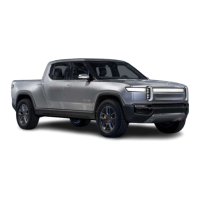4
Summary
This Emergency Response Guide provides information and suggested best practices for mitigating an emergency
with a
Rivian electric vehicle.
RISKS: FIRE, ELECTROCUTION, AND INHALATION HAZARDS
l High-voltage lithium-ion battery fires in electric vehicles differ from gasoline fires because of the chemical
reaction in the battery and high-voltage electricity. Both types of fires can be very dangerous, but an electric
fire may present different risks. As in gasoline vehicle fires, inhalation hazards exist from toxic and/or
flammable gases.
l Always wear personal protective equipment (PPE), including a self-contained breathing apparatus (SCBA), and
use the right tools.
FIRST SECURE THE VEHICLE AND DISCONNECT HIGH VOLTAGE
l Make sure the vehicle is parked and secured from rolling. Stabilize the vehicle if it's not upright or is on an
unstable surface.
l Disconnect the high voltage by severing either cut loop to disconnect the battery from the vehicle.
AVOID ELECTROCUTION
l Certain locations on the vehicle are unsafe to cut during a rescue operation/extrication.
l De-energize the electric circuit or disconnect any damaged or burning vehicle that is connected to a charger.
CONSIDERATIONS DURING A RESCUE OPERATION/EXTRICATION
l Some high-strength steel components may require special equipment.
l Beware of pressurized components that could rupture, fail, or suddenly release during a fire.
BE CAREFUL WHEN MOVING OR STORING A VEHICLE
l Use caution when lifting the vehicle or working with submerged vehicles.
l Tow Rivian electric vehicles on a flatbed only.
l After the fire is extinguished, store the vehicle away from other vehicles and buildings.

